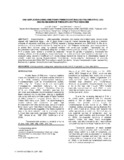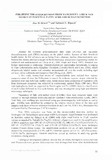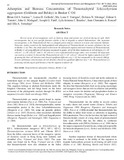Biomass production, proximate composition and fatty acid profile of the local marine thraustochytrid isolate, Schizochytrium sp. LEY7 using low-cost substrates at optimum culture conditions

ดู/เปิด
วันที่
2016Page views
399เมตาดาต้า
แสดงระเบียนรายการเต็มCited times in Scopus
60 readers on Mendeley
Share
นามธรรม
This study was conducted to investigate low-cost substrate alternative and the optimum culture conditions in mass producing the local marine thraustochytrid, Schizochytrium sp. LEY7 isolated from the mangrove leaves of Baybay, Southern Leyte Philippines. Results showed that Schizochytrium sp. LEY7 is able to utilize commercial grade glucose and yeast extract from NaCl-treated baker's yeast as source of carbon and micronutrients respectively. Cost of mass producing the thraustochytrid isolate using the alternative production substrates was substantially reduced. Incubation temperature and salinity levels were the two growth factors significantly affecting the biomass production of the isolate. The short duration of lag phase shown by the isolate suggests a growth advantage in that cells are readily able to adapt to their new environment. Total lipids averaged to 19.4%. Principal fatty acids were palmitic acid (C16:0) with 33.52% and docosahexanoic acid (DHA, C22:6n-3) with 39.92% proportion to total fatty acid. Eicosapentaenoic (C20:5n-3, 1.01%) and arachidonic (C20:4n-3, 0.90%) are present but in relatively lower amount. Our findings showed the potential of low-cost substrate in mass producing the local thraustochytrid isolate, Schizochytrium sp. LEY7 as lipid and polyunsaturated fatty acid source in aquaculture. Biomass production was enhanced by optimizing the culture conditions.
การอ้างอิง
Ludevese-Pascual, G., de la Peña, M. R., & Tornalejo, J. (2016). Biomass production, proximate composition and fatty acid profile of the local marine thraustochytrid isolate, Schizochytrium sp. LEY7 using low-cost substrates at optimum culture conditions. Aquaculture Research , 47(1), 318-328. https://doi.org/10.1111/are.12494
เรื่อง
คอลเลกชัน
- AQD Journal Articles [1248]
รายการที่เกี่ยวข้อง
แสดงรายการที่เกี่ยวข้องตามชื่อผู้แต่งผู้สร้างและเรื่อง
-
DNA amplicons using arbitrary primers distinguish polymorphic loci among mangrove thraustochytrid genomes
Oclarit, Jose M.; Hepowit, Nathaniel L. (Institute of Electrical and Electronics Engineers, 2007)Thraustochytrids - lightly-pigmented estuarine and marine microheterotrophs, taxonomically aligned with heterokont algae - are of great biotechnological interest because they produce substantial amounts of polyunsaturated ... -
Philippine thraustochytrids from mangroves: A rich new source of essential fatty acids for human nutrition
Oclarit, Jose M.; Hepowit, Nathaniel L. (Marine Science Institute, University of the Philippines, 2007) -
Adsorption and biomass concentration of thraustochytrid Schizochytrium aggregatum (Goldstein and Belsky) in Bunker C Oil
Sarinas, Brian Gil S.; Gellada, Lorna D.; Torrigue, Ma. Lona T.; Sibonga, Dolores N.; Torrato, Edmar S.; Malagad, John G.; Feril, Joseph G.; Bondoc, Lyle Arianne J.; Roncal, Juan Clemente A.; Tornalejo, Jilla A. (School of Environmental Science and Management, University of the Philippines Los Baños, 2014)Diverse array of microorganisms such as bacteria, fungi and protists are involved during oil spill. Each microorganism has its own specific function whether it has to degrade or adsorb hydrocarbons. One important microorganism ...



